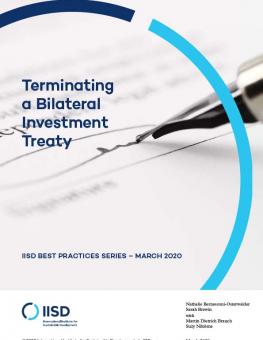
IISD Best Practices Series: Terminating a Bilateral Investment Treaty
This paper examines recent state practice in bilateral investment treaty (BIT) terminations and related drafting, along with presenting options for states interested in addressing their stock of older BITs through termination and renegotiation.
This paper from IISD's Best Practices series examines recent state practice in bilateral investment treaty (BIT) terminations and related drafting, along with presenting options and recommendations for states interested in addressing their stock of older BITs through termination and renegotiation.
The paper begins by examining treaty termination in the context of public international law, along with the types of termination clauses that are common in BITs. It then examines recent trends in the drafting of termination and survival clauses in investment treaties. The paper considers how these terminations are implemented in practice, as well as what states have done to address survival clauses when terminating these treaties. Lastly, the paper sets out factors that states may wish to consider in deciding how to terminate a BIT, and outlines recommendations for preparing for and carrying out termination.
Additional downloads
You might also be interested in
IISD Best Practices Series: Registration and Approval Requirements in Investment Treaties
This paper analyzes registration and approval requirements for investments in investment treaties, and examines the interpretation of such provisions by arbitral tribunals.
Transparency in the Dispute Settlement Process: Country best practices
In many investor-state arbitrations, it is difficult or impossible even to know that the dispute has been initiated, what the issues and arguments are, and what decisions or awards have been made to resolve the matter.
CSDDD: EU's Due Diligence Law Vote Should Drive Supply Chain Sustainability Efforts
The European Parliament has voted to adopt the Corporate Sustainability Due Diligence Directive, aiming to address the environmental and social impacts of the supply chains of Europe's large corporations.
Ecuador Referendum Rules Out ISDS Return, Underlining Public Support for a Sustainable Path
Ecuador has voted to allow international arbitration and investor–state dispute settlement (ISDS) in its treaties and agreements. But the risks that initially made them turn away from this outdated model remain.